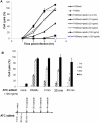Type III secretion of ExoU is critical during early Pseudomonas aeruginosa pneumonia
- PMID: 23481600
- PMCID: PMC3604777
- DOI: 10.1128/mBio.00032-13
Type III secretion of ExoU is critical during early Pseudomonas aeruginosa pneumonia
Abstract
The Pseudomonas aeruginosa type III secretion system has been associated with poor outcomes in both animal models and human patients. Despite a large number of studies exploring the regulation of type III secretion in vitro, little is known about the timing of secretion during mammalian infection. Here we demonstrate that the exoU gene, which encodes the highly cytotoxic type III effector ExoU, is induced early during acute P. aeruginosa pneumonia. Immunofluorescence microscopy indicated that the amount of ExoU protein in the lung also increased over time. The importance of early expression was examined using a strain of P. aeruginosa with inducible production of ExoU. Delays in expression as short as 3 h led to reduced bacterial burdens in the lungs of mice and improved survival. Our results demonstrate that early expression of exoU is critical to bacterial survival during pneumonia and suggest that therapeutic interventions that delay ExoU secretion for even short periods of time may be efficacious.
Importance: Pseudomonas aeruginosa is a major contributor to the large numbers of health care-associated infections occurring annually, particularly for immunocompromised patients. Although this organism possesses many virulence factors, the type III secretion system plays an especially important role in both animal models and humans. This system forms a needle-like apparatus that injects toxins directly into eukaryotic cells. The most toxic protein secreted by this molecular machine is ExoU, which causes rapid cell death. In this study, we demonstrated that exoU was expressed and ExoU was produced early during acute pneumonia in a mouse model. Delaying expression of exoU by as little as 3 h enhanced clearance of bacteria and survival of infected mice. Our findings highlight the importance of understanding the regulation of virulence factor expression during infection when designing therapeutic strategies to inhibit the toxic effects of these proteins.
Figures





References
-
- Troisfontaines P, Cornelis GR. 2005. Type III secretion: more systems than you think. Physiology (Bethesda) 20:326–339 - PubMed
-
- Preston GM. 2007. Metropolitan microbes: type III secretion in multihost symbionts. Cell Host Microbe 2:291–294 - PubMed
-
- Diaz MR, King JM, Yahr TL. 2011. Intrinsic and extrinsic regulation of type III secretion gene expression in Pseudomonas aeruginosa. Front. Microbiol. 2:89 http://dx.doi.org/10.3389/fmicb.2011.00089 - PMC - PubMed
Publication types
MeSH terms
Substances
Grants and funding
LinkOut - more resources
Full Text Sources
Other Literature Sources
